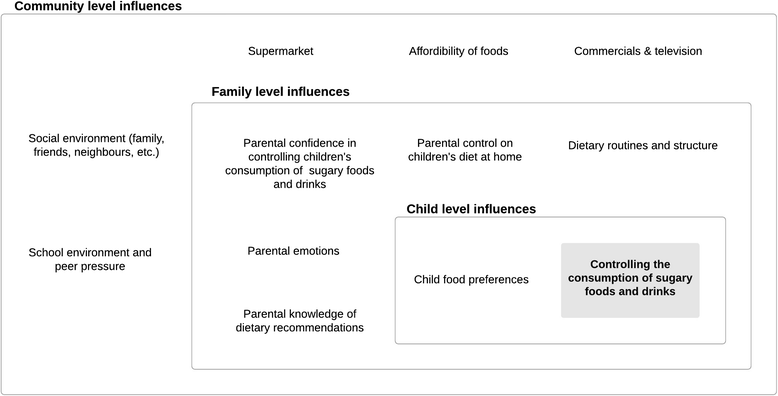Establishing oral health promoting behaviours in children - parents' views on barriers, facilitators and professional support: a qualitative study
- PMID: 26654364
- PMCID: PMC4676163
- DOI: 10.1186/s12903-015-0145-0
Establishing oral health promoting behaviours in children - parents' views on barriers, facilitators and professional support: a qualitative study
Abstract
Background: The prevention of childhood dental caries relies on adherence to key behaviours, including twice daily tooth brushing with fluoride toothpaste and reducing the consumption of sugary foods and drinks. The aim of this qualitative study was to explore parents' perceptions of barriers and facilitators that influence these oral health behaviours in children. A further objective was to explore parents' views on limitations and opportunities for professional support to promote children's oral health.
Methods: Six focus group interviews were conducted, including a total of 39 parents of 7-year old children, who were recruited from paediatric dental centres in The Netherlands. Interviews were held with Dutch parents of low and high socioeconomic status and parents from Turkish and Moroccan origin. Focus group interviews were conducted on the basis of a pre-tested semi-structured interview guide and topic list. Content analysis was employed to analyse the data.
Results: Analysis of interview transcripts identified many influences on children's oral health behaviours, operating at child, family and community levels. Perceived influences on children's tooth brushing behaviour were primarily located within the direct family environment, including parental knowledge, perceived importance and parental confidence in tooth brushing, locus of control, role modelling, parental monitoring and supervision, parenting strategies and tooth brushing routines and habituation. The consumption of sugary foods and drinks was influenced by both the direct family environment and factors external to the family, including the school, the social environment, commercials and television, supermarkets and affordability of foods. Parents raised several suggestions for professional oral health support, which included the provision of clear and consistent oral health information using a positive approach, dietary regulations at school and a multidisciplinary approach among dental professionals, child health centres and other institutions in providing parental support.
Conclusion: In conclusion, this qualitative study provided detail regarding parental views on the influences on children oral health behaviours and their opinions on what further support is needed to promote children's dental health. Parents' suggestions for professional oral health support can guide the development or improvement of caries preventive interventions.
Figures
Similar articles
-
Promoting parenting strategies to improve tooth brushing in children: design of a non-randomised cluster-controlled trial.BMC Oral Health. 2019 Sep 6;19(1):210. doi: 10.1186/s12903-019-0902-6. BMC Oral Health. 2019. PMID: 31492121 Free PMC article.
-
Barriers and opportunities to oral health in Dutch-Moroccan children in the Netherlands: a narrative report.Eur Arch Paediatr Dent. 2018 Oct;19(5):353-364. doi: 10.1007/s40368-018-0367-3. Epub 2018 Aug 20. Eur Arch Paediatr Dent. 2018. PMID: 30128697 Free PMC article.
-
Parents' perceived barriers and enablers to providing optimal infant oral care.BMC Public Health. 2025 Apr 5;25(1):1292. doi: 10.1186/s12889-025-22487-9. BMC Public Health. 2025. PMID: 40188064 Free PMC article.
-
[The family's influence on the oral health of children. A peek behind the front door].Ned Tijdschr Tandheelkd. 2017 Apr;124(4):180-186. doi: 10.5177/ntvt.2017.04.16202. Ned Tijdschr Tandheelkd. 2017. PMID: 28418412 Review. Dutch.
-
[Social inequalities in oral health and early childhood caries: How can they be effectively prevented? A scoping review of disease predictors].Rev Epidemiol Sante Publique. 2020 Aug;68(4):201-214. doi: 10.1016/j.respe.2020.06.004. Epub 2020 Jul 4. Rev Epidemiol Sante Publique. 2020. PMID: 32631663 French.
Cited by
-
Relationship between dental experiences, oral hygiene education and self-reported oral hygiene behaviour.PLoS One. 2022 Feb 24;17(2):e0264306. doi: 10.1371/journal.pone.0264306. eCollection 2022. PLoS One. 2022. PMID: 35202439 Free PMC article.
-
Diet, Nutrition, and Oral Health: What Influences Mother's Decisions on What to Feed Their Young Children?Int J Environ Res Public Health. 2021 Aug 2;18(15):8159. doi: 10.3390/ijerph18158159. Int J Environ Res Public Health. 2021. PMID: 34360452 Free PMC article.
-
Parental Attitudes towards Child Oral Health and Their Structural Analysis.Children (Basel). 2024 Mar 11;11(3):333. doi: 10.3390/children11030333. Children (Basel). 2024. PMID: 38539368 Free PMC article.
-
Effective Prevention of Early Childhood Caries in Well-Baby Clinics: Results of a Pragmatic Randomized Trial.Caries Res. 2025 Mar 18:1-15. doi: 10.1159/000545116. Online ahead of print. Caries Res. 2025. PMID: 40101698 Free PMC article.
-
Evaluation of a Maternal Behavior Change Communication (MBCC) dental public health intervention on pregnant women to prevent early childhood caries in their infants: a study protocol for a randomized controlled trial.BMC Public Health. 2025 Jul 30;25(1):2597. doi: 10.1186/s12889-025-23761-6. BMC Public Health. 2025. PMID: 40739490 Free PMC article.
References
-
- Harris R, Nicoll AD, Adair PM, Pine CM. Risk factors for dental caries in young children: a systematic review of the literature. Community Dent Health. 2004;21(supplement):71–85. - PubMed
-
- Department of Health, the British Association for the Study of Community Dentistry. Delivering Better Oral Health: An evidence-based toolkit for prevention (3rd edition). 2014.
-
- Kay L, Locker D. Is dental health education effective? A systematic review of current evidence. Community Dent Oral Epidemiol. 1996;31:3–24. - PubMed
Publication types
MeSH terms
LinkOut - more resources
Full Text Sources
Other Literature Sources
Medical



